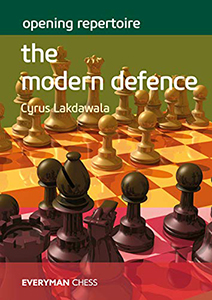Modern Defense, The
Cyrus Lakdawala

The English firm Everyman Chess, formerly Cadogan Chess, has been one of the leading publishers in the field for approximately four decades. Garry Kasparov’s My Great Predecessors series is the best-known of the books Everyman has published, but what really has put the company on the map is its “move by move” format where frequent questions and exercises engage the reader and help them in the learning experience. Two of Everyman’s recent offerings utilize this approach.
San Diego International Master Cyrus Lakdawala is one of the workhorses for Everyman and has written dozens of books for them covering all aspects of the game. This productivity sometimes leads to authors running out of ideas but that has not been a problem for Lakdawala who has found a second career in writing now that his playing days are over.
His enthusiasm for the subject is evident in The Modern Defense which offers a complete opening repertoire for Black. The heart of Lakdawala’s answer to 1.e4 is the sequence 1…g6 2.d4 d6 3.Nc3 c6. Delaying the development of Black’s king bishop not only discourages hyper-aggressive White systems based on Bc4 (met by a well-timed …d5) or Be3, Qd2 and Bh6 (not playing …Bg7 saves a tempo to accelerate play elsewhere) it actually can win time against the Austrian Attack.
Lakdawala explains that after 1.e4 g6 2.d4 Bg7 3.Nc3 c6 4.f4 d5 5.e5 the Black king bishop is misplaced and belongs on the f8-a3 diagonal. His solution: 1.e4 g6 2.d4 d6 3.Nc3 c6 4.f4 d5 5.e5 when Black’s d-pawn has taken two moves to reach d5, but his position is actually better as the bishop on f8 is preferable to being on g7. This line, which relies on positional understanding, is much easier to learn than analogous variations of the Austrian Attack in the Pirc (1.e4 d6 2.d4 Nf6 3.Nc3 g6 4.f4) which are considerably more theoretical.
After 1.d4 g6 2.c4 Black’s choices are limited if he doesn’t want to transpose into the King’s Indian Defense. Lakdawala in his 2012 book The Modern Defence: Move by Move (also published by Everyman) advocated 1.d4 g6 2.c4 Bg7 3.Nc3 d6 4.e4 e5 which has been doing well of late at the top levels. Here he offers something different: 1.d4 g6 2.c4 Bg7 3.Nc3 c5 4.d5 d6 5.e4 e6 6.Nc3 Ne7. This unusual Benoni was played as far back as 1961 – by no less than Tigran Petrosian – but has only recently caught on.
The Modern Defense also offers lines against the English and other White first move options. In particular the move-order 1.d4 g6 works well against the popular London system as Black is well-positioned to play a quick …e5 harassing the bishop on f4.
Players from 1800-2300, who have a solid foundation having mastered basic opening principles by answering 1.e4 with 1…e5, and who are looking to branch out, will find The Modern Defense an excellent first step.
